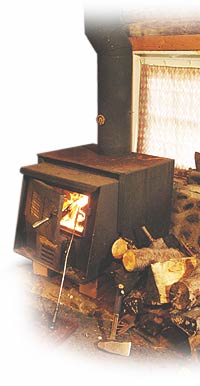Wood Energy Content
Unless you have a free source of fuel or electricity, wood is the least expensive way to heat your home. With the rising cost of petroleum products, heating with wood makes sense.
Here's how the energy content of various fuels and wood compare. To generate a specific heating cost for your home using different fuels, try our heating cost calculator »
| Fuel type: | Density: | Lbs per Cord | Energy Content |
| Birch1 | 41.0 | 3,485 | 23,600,000 Btu/cord |
| Hemlock1 | 33.6 | 2,856 | 22,000,000 Btu/cord |
| White Spruce1 | 30 | 2,550 | 18,100,000 Btu/cord |
| Sitka Spruce1 | 30 | 2,550 | 18,100,000 Btu/cord |
| Alder (Southweast) | 28.4 | 2,540 | 17,500,000 Btu/cord |
| Aspen1 | 28.4 | 2,414 | 16,600,000 Btu/cord |
| Tamarack2 | 38.2 | 3,247 | 16,000,000 Btu/ton |
| Black Spruce2 | 29.2 | 2,482 | 15,900,000 Btu/cord |
| Balsam Poplar1 | 25.5 | 2,168 | 15,000,000 Btu/cord |
| Cottonwood2 | 24.8 | 2,108 | 14,500,000 Btu/cord |
| Wood Pellets | 16,000,000 Btu/ton | ||
| Lignite Coal3 | 17,400,000 Btu/ton | ||
| Oil3 | 134,000 Btu/gal | ||
| Electricity3 | 3,413 Btu/kWh | ||
| Natural Gas3 | 1,000 Btu/ft3 | ||
| Propane3 | 91,800 Btu/gal | ||
|
1 - values taken from Purchasing Firewood in Alaska published 10/96, AK DNR/DOF/CFP. 2 - values taken from The Encyclopedia of Alternative Energy and Sustainable Living; 16 July 2006 3 - Values taken from Heating Values of Fuels by Rich Seifert |
|||
Less dense wood have less material for combustion and may require two cords to produce the same heat as one cord of a heavier, denser wood. Some examples of low-heat firewoods “include willows, basswood, cottonwood, and yellow (tulip) poplar. Seasoned, they weigh only about half as much as denser species, even though their high moisture content when green may suggest they are denser than they are. They're not good for heating because they burn up quickly, but can serve well as kindling, also because they split easily.”1
The Btu values are based on dry or seasoned wood with 20% moisture. Wet or green wood has higher moisture and requires a large amount of heat to evaporate the moisture before the wood can burn and give off heat. Cutting firewood in the late winter and early spring allows the wood to dry through the summer and be ready for the coming winter.
Driftwood washes up along the coast and the Yukon and Kuskokwim rivers. It can be burned in Southwest and the Interior for home heating as well as smoking fish, carving, making kayaks and heating steam baths. Use caution when cutting driftwood; it collects sand, silt and gravel while traveling downriver which will dull the chain sometimes beyond repair.2
Use care when burning ocean driftwood with its considerable amounts of salt. When burned, these salts are highly corrosive to wood stoves and chimneys. Also, check chimneys more often for mineral build up.
Some things should never be burned–garbage, plastic, foil, pretreated lumber or fence posts or painted wood–because they produce noxious, polluting fumes.3 And don't use chemically treated wood scraps; they produce toxic and possibly cancer-causing gases. Toxic compounds also concentrate in the ash. Most important, never burn wood treated with a preservative such as creosote, pentachlorophenol or inorganic salts.4
1. Soderstrom, Neil. "Get Your Firewood This Summer." About Town Articles & Stories. AboutTown. 20 Jul 2006 http://www.abouttown.us/dutchess/articles/summer02/firewood.shtml.
2. Alix, Clair, Brewster, Karen "Not All Driftwood is Created Equal: Wood Use and Value Along the Yukon and Kuskokwim Rivers, Alaska" Alaska Journal of Anthropology 2(1)(2004): 2-19.
3. "Straight Answers to Burning Questions: Quick Tips for Cleaner, More Efficient Wood Heat." hpba.org. 2006. Hearth, Patio & Barbeque Association. 20 Jul 2006 http://hpba.org/communications/FactSheets/answers.shtml.
4. Shelly, John. "FOR-35 Firewood." U of Kentucky College of Agriculture publications. 01July1986. University of Kentucky. 20 Jul 2006 http://www.ca.uky.edu/agc/pubs/for/for35/for35.htm.
Also see:
- On-line heat cost calculator
Compare the costs of different fuels - Home Heating applications
Learn how to heat your home most effectively - Wood availability by region
Learn what species are available to you, and what they may cost

